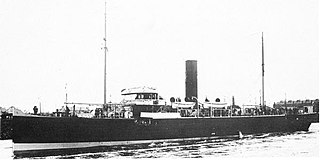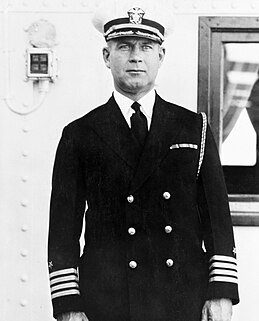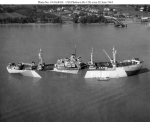Related Research Articles

Q-ships, also known as Q-boats, decoy vessels, special service ships, or mystery ships, were heavily armed merchant ships with concealed weaponry, designed to lure submarines into making surface attacks. This gave Q-ships the chance to open fire and sink them. The use of Q-ships contributed to the abandonment of cruiser rules restricting attacks on unarmed merchant ships and to the shift to unrestricted submarine warfare in the 20th century.
SS City of Flint, a Hog Islander freighter built by American International Shipbuilding at the Hog Island Shipyard, Philadelphia for the United States Shipping Board (USSB), Emergency Fleet Corporation. City of Flint was named to honor the citizens of Flint, Michigan for their effort in Liberty Loan drives during World War I.

Ernest Joseph King was Commander in Chief, United States Fleet (COMINCH) and Chief of Naval Operations (CNO) during World War II. As COMINCH-CNO, he directed the United States Navy's operations, planning, and administration and was a member of the Joint Chiefs of Staff. He was the United States Navy's second most senior officer in World War II after Fleet Admiral William D. Leahy, who served as Chief of Staff to the Commander in Chief.

Isaac Campbell Kidd was an American Rear Admiral in the United States Navy. He was the father of Admiral Isaac C. Kidd, Jr. Kidd was killed on the bridge of USS Arizona during the Japanese attack on Pearl Harbor. The highest ranking casualty at Pearl Harbor, he became the first U.S. Navy flag officer killed in action in World War II as well as the first killed in action against any foreign enemy.

Joseph Mason "Bull" Reeves was an admiral in the United States Navy and an early and important supporter of U.S. Naval Aviation. Though a battleship officer during his early career, he became known as the "Father of Carrier Aviation" for his role in integrating aircraft carriers into the Fleet as a major part of the Navy's attack capabilities.

Norman (Nicholas) Scott was a rear admiral in the United States Navy, and was one of only two U.S. Navy admirals killed in action during a surface battle in World War II. Scott posthumously received the Medal of Honor for his actions in the Pacific Theater of World War II.

Franklin Van Valkenburgh was an American naval officer who served as the last captain of the USS Arizona (BB-39). He was killed when the Arizona exploded and sank during the attack on Pearl Harbor.

The Mediterranean Squadron, also known as the Mediterranean Station, was part of the United States Navy in the 19th century that operated in the Mediterranean Sea. It was formed in response to the First and Second Barbary Wars. Between 1801 and 1818, the squadron was composed of a series of rotating squadrons. Later, squadrons were sent in the 1820s to the 1860s to suppress piracy, primarily in Greece and to engage in gunboat diplomacy. In 1865 the force was renamed the European Squadron.

USS Doherty (DE-14) was an Evarts class destroyer escort constructed for the United States Navy during World War II. She was sent off into the Pacific Ocean to protect convoys and other ships from Japanese submarines and fighter aircraft. She performed escort and antisubmarine operations in dangerous battle areas and returned home safely at war's end.

USS Thomas (DE-102) was the second United States Navy ship to be named after Clarence Crase Thomas.

USS Picket (YAGR/AGR-7) was a Guardian-class radar picket ship, converted from a Liberty Ship, acquired by the US Navy in 1955. She was obtained from the National Defense Reserve Fleet and reconfigured as a radar picket ship and assigned to radar picket duty in the North Pacific Ocean as part of the Distant Early Warning Line.

USS Joseph Hewes (AP-50/APA-22), formerly SS Excalibur, was a troop transport for the United States Navy during World War II commanded by Captain Robert McLanhan Smith Jr. A part of the Center Attack Group of Admiral Hewitt's Western Naval Task Force, Operation Torch, Joseph Hewes was sunk on November 11, 1942 by the German submarine U-173 in Fedala Roads off French Morocco coast during the Naval Battle of Casablanca.

USS Phobos (AK-129) was a Crater-class cargo ship commissioned by the U.S. Navy for service in World War II. She was responsible for delivering troops, goods and equipment to locations in the war zone.

John Barry was an Irish-American officer in the Continental Navy during the American Revolutionary War and later in the United States Navy. He has been credited as "The Father of the American Navy" and was appointed a captain in the Continental Navy on December 7, 1775. He was the first captain placed in command of a U.S. warship commissioned for service under the Continental flag.

United States Navy operations during World War I began on April 6, 1917, after the formal declaration of war on the German Empire. The American navy focused on countering enemy U-boats in the Atlantic Ocean and the Mediterranean Sea, while convoying men and supplies to France and Italy. Because of United States' late entry into the war, her capital ships never engaged the German fleet, and few decisive submarine actions occurred.
The third HMS Hoste (K566), ex-Mitchell, was a Captain-class frigate of the Evarts-class of destroyer escort, originally commissioned to be built for the United States Navy. Before she was finished in 1943, she was transferred to the Royal Navy under the terms of Lend-Lease, and saw service during the World War II from 1943 to 1945.

The second HMS Foley (K474) was a British Captain-class frigate of the Royal Navy in commission during World War II. Originally constructed as the United States Navy Evarts-class destroyer escort USS Gillette (DE-270), she served in the Royal Navy from 1943 to 1945 and in the U.S. Navy as USS Foley (DE-270) from August to October 1945.
HMS Garlies (K475) was a British Captain-class frigate of the Royal Navy in commission during World War II. Originally constructed as the United States Navy Evarts-class destroyer escort USS Fleming (DE-271), she served in the Royal Navy from 1943 to 1945 and in the U.S. Navy as USS Garlies (DE-271) from August to October 1945.

HMS Grindall (K477) was a British Captain-class frigate of the Royal Navy in commission during World War II. Originally constructed as the United States Navy Evarts-class destroyer escort USS Sanders (DE-273), she served in the Royal Navy from 1943 to 1945 and then in the U.S. Navy as USS Grindall (DE-273) from August to October 1945.
HMS Kingsmill (K484) was a British Captain-class frigate of the Royal Navy in commission during World War II. Originally constructed as the United States Navy Evarts-class destroyer escort DE-280, she served in the Royal Navy from 1943 to 1945 and then in the U.S. Navy as USS Kingsmill (DE-280) from August to October 1945.
References
- This article incorporates text from the public domain Dictionary of American Naval Fighting Ships .
- history.navy.mil: USS Gainard
- Joseph A. Gainard, Yankee Skipper: The Life Story of Joseph A. Gainard, Captain of the City of Flint (New York: Frederick A. Stokes Company, 1940).